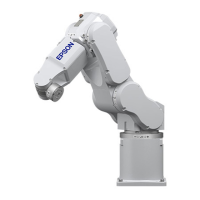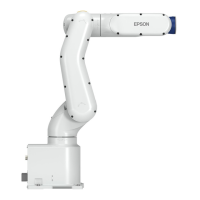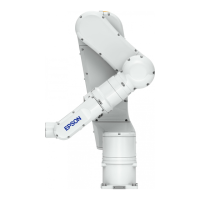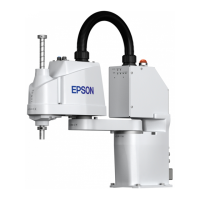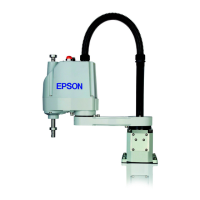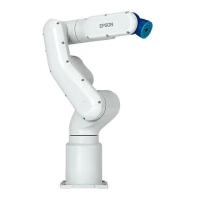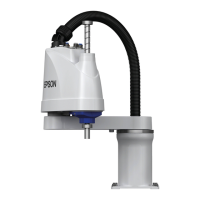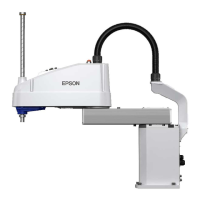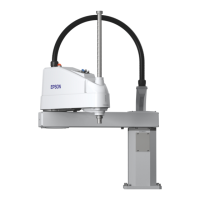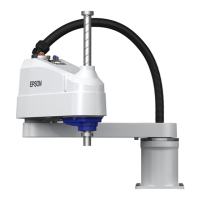Setup & Operation 5. Motion Range
74 G6 Rev.21
a hexagon socket head cap bolt into the hole corresponding to the setting angle,
and
Hexagon socket head cap
bolt (fully threaded)
Recommended
tightening torque
1
M10 × 20
1 bolt /
one side
127.4 N⋅m (1300 kgf⋅cm)
2
M8 × 10
37.2 N⋅m (380 kgf⋅cm)
Set the pulse range corresponding to the new positions of the mechanical stops.
Be sure to set the pulse range
inside the positions of the mechanical stop range.
Using G6-**1S*
The angle of Joint #1 is set from –135 degrees to +135 degrees.
The angle of Joint #2 is set from
125 degrees to +125 degrees.
Execute the following command
s from the [Command Window].
>JRANGE 1,-1310720,6553600 ' Sets the pulse range of Joint #1
>JRANGE 2,-2275556,+2275556 ' Sets the pulse range of Joint #2
>RANGE ' Checks the setting using Range
-1310720,6553600,-2275556,2275556,-1976708
,0,-1961226, 1961226
hand until it touches the mechanical stops
, and make sure that the
arm does not hit
any peripheral equipment during operation.
perate the joint changed at low speeds until it reaches the positions of the
maximum pulse range. Make sure t
hat the arm does not hit the mechanical
stops.
(Check the position of the mechanical stop and the motion range you set.)
: Using G6-**1S*
The angle of Joint #1 is set from -85 degrees to +115 degrees.
The angle of Joint #2 is set from
132 degrees to +132 degrees.
Execute the following command
s from the [Command Window].
>MOTOR ON ' Turns ON the motor
>CP ON ' Enters low-power mode
>SPEED 5 ' Sets at low speeds
>PULSE -1310720,0,0,0 ' Moves to the min. pulse position of Joint #1
>PULSE 6553600,0,0,0 ' Moves to the max. pulse position of Joint #1
>PULSE 2621440,-2275556,0,0 ' Moves to the min. pulse position of Joint #2
>PULSE 2621440,2275556,0,0 ' Moves to the max. pulse position of Joint #2
Pulse command (Go Pulse command) moves all joints to the specified position
Specify safe positions after considering motion of not only the
joints whose pulse range have been changed, but also other joints
In this example, Joint #1 is moved to the
center of its motion range
) when checking Joint #2.
is hitting the mechanical stop
s or if an error occurs after the arm hits the
mechanical stops
, either reset the pulse range to a
narrower setting or extend the
position
s of the mechanical stops within the limit.
